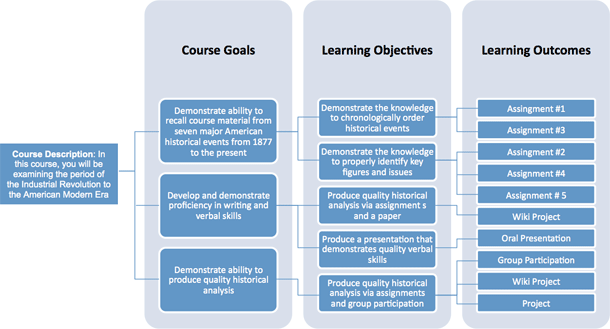First Things First
The melding of the face-to-face and online environments in blended learning offers a unique set of opportunities and challenges in the course design process. Although many factors intervene in successfully building your blended course, defining your teaching, and learning philosophy at first lays a solid foundation for the development of a quality course. Knowing where you stand on what constitutes teaching and learning will help you envision the protocols and strategies throughout the life of a course from its creation to its delivery.
Before delving into the type of content or technology to incorporate in your blended course, charting the direction to pursue is fundamental. A course blueprint provides such direction which will prove useful while designing, building and delivering the blended course. Generally, a course blueprint encompasses four elements as follows:
- Course description: portrays what the course is going to cover. Institutional course catalogs are a great starting point to convey and describe the course you are building for your learners.
- General course goals: outlines the overarching targets and focus of the course.
- Learning objectives: defines the desired measurable learning objectives students will achieve upon course completion.
- Learning outcomes: defines the means through which students will demonstrate proficiency in learning and realizing the objectives established for the course.

Course Blueprint: This diagram is an example of a course blueprint for a History course.
The Nitty Gritty
Critical success factors when building your blended course entail the proper amalgamation of teaching and learning strategies for you as the facilitator of learning, your students, and the learning environment. The key areas to bear in mind as you build your course are:
-
Instructional Method:
Should I write an online module on this topic? Should the group discussion take place in class? Is a demonstration of the concept more suitable in the online portion of the course? These questions are examples of some of the issues you might be looking to answer as you build your blended course. Essentially, the question to ask is how the specific learning objective at hand can be delivered most effectively. That is, determine whether the content or interaction of the course should be addressed in the face-to-face class session, online, or both. The one caveat to keep in mind is to avoid unintended replication that could be perceived as pointless by your students.
-
Organization of the Course Content and Supporting Materials:
Besides determining the coverage in terms of depth and breadth, consider what constitutes the most suitable sequencing and transition between the online and face-to-face portions of your blended course. Other elements to consider are if you should adopt existing content of your own or a publisher’s packaged course. The key is to organize the content of your course in a complementary way while filling in the existing gaps.
-
Defining a Course Interaction and Assessment Strategy:
Determining the types of activities, assignments, interactive exercises and assessment is crucial as students need to understand the applicability of what they are learning. Providing sufficient examples and opportunities to practice the knowledge and skills they are acquiring is key for their self-assessment and your assessment on whether they are closer to achieving the proficiency expected of them. For instance, watching a video segment prior to class could lay the foundation for a class discussion. Online discussions can be used to carry on a conversation that students found very interesting during a class session. Games could be used as a starter to a conversation or to self-assess. The possibilities are endless.
-
Communication:
Communication and feedback are crucial in building a quality and satisfactory blended learning experience. Some of the most successful communication approaches encourage plenty of appropriate student-to-faculty contact; collaboration and interaction among students; prompt feedback; and communication of expectations and protocols from the very beginning of the course. The key is to be cognizant of the diverse needs and talents of students through a consistent and clear communication strategy, whether online or face-to-face.
-
Logistical Considerations:
Lastly, for a comprehensive approach to building a blended course, awareness of the technologies, services, and support available to you and your students can be very valuable. For instance, knowing the protocols of your institution’s technical support can shape your communication strategy in terms of how promptly your students can get additional help when a technology problem arises. If your institution’s library or writing center provides modules and other materials, you could incorporate such content in your blended course. Referrals to services across the campus are most useful to your students as an extension of your role as a facilitator of learning.
Conclusion
To conclude, the successful creation of a blended course is highly dependent on the ultimate goals and the learning objectives students are to achieve at the end of the course. No one course will be completely perfect. The aim is to build a blended course that balances the best of both worlds, online and face-to-face, to help students achieve the course goals and learning objectives. Please see the BlendKit Course’s do-it-yourself task guides for more detailed resources supporting the development of blended learning courses.




